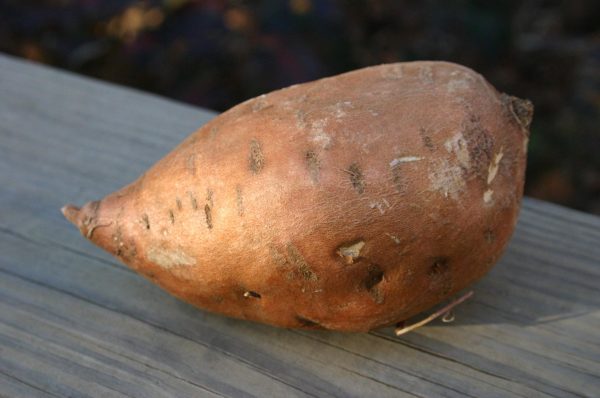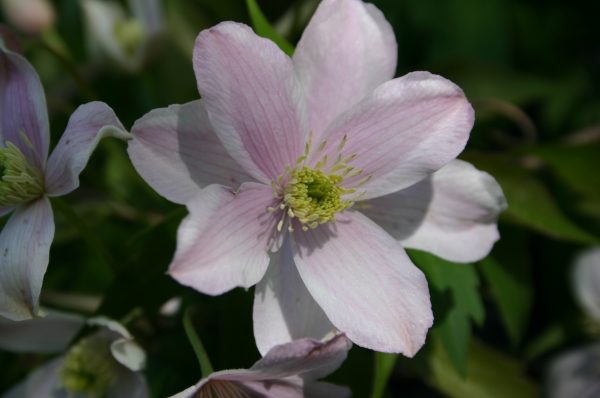Sweet Potato

Sweet Potato
Ipomoea batatas
Because of their need for long, warm growing conditions, sweet potatoes are often thought of as an exclusive Southern crop – in fact, most of the tropical world depends heavily on the sugary, easy-to-grow member of the morning glory family for both sugar and starch.
• More detailed information can be found in The Georgia Fruit & Vegetable Book by Walter Reeves and Felder Rushing
• See also
Growing Your Own Sweet Potato Slips
(broken link)
Its vigorous, ground-hugging vines are ornamental with lobed leaves (including some popular colorful varieties such as ‘Blackie’ and ‘Margarita’), and its roots, depending on variety, have a rich or mellow taste, and textures ranging from creamy or dry to dense and even stringy. And nothing beats a sweet potato pie or fried sweet potatoes!
When to Plant
Sweet potatoes are one of the few vegetables that require warm soils. Wait at least two weeks after last frost, when the soil temperatures are consistently in the upper 60’s or higher, before planting. They take nearly four months or more from setting the plants until harvest.
Where to Plant
Select a site that is sunny and hot. Yield is low when sweet potatoes are planted in heavy or wet soils, and those over-fertilized with nitrogen, so for good root growth and easy harvest, select a soil that is loose and well-drained, and fertilize with a low-nitrogen fertilizer. Though good crops may be produced in acidic or alkaline soils, soil rot is less of a problem on acidic soils. To reduce insect and disease buildup, rotate planting sites from year to year.
How to Plant
Rooted vine cuttings called “slips” are buried directly into warm soil, a foot apart in rows three feet apart, or on mounds 4 feet apart; bury them so only their stem tips and two or three leaves are left showing. Many gardeners grow their own slips from sweet potatoes saved over the winter and buried in moist sand until they sprout; however, because this often leads to insect or disease infestation, it is best to purchase fresh slips, sold in bundles, every spring. For additional plantings, take cuttings several inches long from new growth in late spring or early summer, and stick directly into the moist soil.
Care and Maintenance
Do not over-fertilize or over-water sweet potato vines! A light side-dressing of low-nitrogen, high-potash fertilizer one month after planting can increase yield somewhat, and a slow, deep soaking every three or four weeks will help keep vines growing steadily. Major problems include soil rot, soil insects (especially the larvae of sweet potato weevil, for which there currently is no adequate control other than diligent and regular crop rotation), a skin-staining fungus called “scurf” (mostly cosmetic), and interrupted growth caused by long periods of drought.
Additional Information
Many varieties of the sweet potato, which is very closely related to morning glory, often flower late in the season. Dig sweet potato roots when the soil is fairly dry and the air is warm. Early harvesting results in many small roots; late harvest leads to jumbo roots and possible cold injury; cracked roots often result from sudden heavy rains close to harvest.
The skin of sweet potatoes is thin and easily damaged; handle freshly-dug roots gently – don’t even wash them when dug. Move them quickly into shade to prevent sun scald, and allow to “cure” for several days for cuts and bruises to heal and for starchy insides to convert to sugar, then move to a humid, warm storage. If exposed to temperatures below 50 degrees, potatoes may develop hard spots in the roots and begin to break down.
Varieties
Sweet potato varieties come and go according to commercial demand. One or two of the following are usually locally available at garden supply stores:
Porto Rico
old “bunch” type, variable root shape with copper skin and orange flesh. Delicious “old-fashioned” flavor, and excellent baking potato. Small “baby bakers” in 110 days.
Centennial
America’s leading variety. Heavy production of tapered cylindrical roots of medium to large size, with orange skin and deep orange, soft flesh. Vines thick and vigorous, tolerates clay soils. “Baby bakers” in 90 days.
Beauregard –
high yielding with some disease resistance, light rose skin and deep orange flesh. Matures early (105-110 days)
Jewel
“Queen of Sweet Potatoes. Yam type (moist, soft, yellow-fleshed when baked), blocky shaped with smooth copper skin and orange flesh. Very high yield (up to six potatoes per plant), needs 120-135 days for best production. Good baking quality and low fiber content
Nancy Hall
popular old variety, light yellow flesh. Juicy, sweet when baked.
Yellow Jersey
“old fashioned” potato with golden yellow skin and creamy white flesh. Dry flesh.
Vardaman – bush variety with large roots and deep orange flesh. Beautiful ornamental foliage.
Golden yellow outside skin, with deepest, brightest orange flesh of all.
Recipe: “Mother-in-law’s Request” sweet potato pie
Bake 6 cured sweet potatoes at 325 degrees for 1 1/2 hours (stick several fork holes in skin to release steam during baking). Peel, and mix thoroughly with with 1/2 cup margarine, 1 tsp. baking powder, 1 tsp. Vanilla, 1 tsp ground cinnamon, 2 eggs, 3/4 cup sugar, 3/4 cup buttermilk, and (barely optional) 3/4 cup chopped pecans. Bake in greased 2-quart casserole at 350 degrees for 30 minutes. Top with marshmallows during last 10 minutes of baking. Your mother-in-law will request it from now on.













